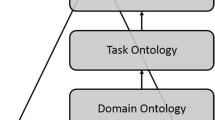Abstract
Understanding statistical results is crucial in order to spread right conclusions. In observational studies, statistical results are often reported as associations without going further. However, each association comes from causal relations. Causal diagrams are visual representations enabling to understand causal mechanisms behind the association found. In the era of big data and growing number of variables, visual approaches become inefficient. Ontological representation of causality and reasoning could help to explain statistical results. OntoBioStat is a domain ontology related to covariate selection and bias for biostatistician users. It was designed using expert corpus from comprehensive literature review, and validated by three biostatisticians accustomed to causal diagrams. In this paper, we focused on the presentation of an OntoBioStat’s feature able to infer explanations about statistical associations. The ontologization of the feature of interest resulted in 14 object properties, three classes and five Semantic Web Rule Language rules. Each rule allows to infer a different object-property that explains statistical association between two variables. Rules are based on isCauseof statements between different individuals. OntoBioStat feature performances were illustrated through a real-life retrospective observational study. From 28 instances and 48 object properties stated, a set of 1,939 object properties were inferred. OntoBioStat explained 65% of the 48 statistical associations found. In conclusion, OntoBioStat could help to explain a part of the significant statistical associations between two variables but cannot yet predict significant ones.
Access this chapter
Tax calculation will be finalised at checkout
Purchases are for personal use only
Similar content being viewed by others
References
Rothman, K.J., Greenland, S.: Causation and causal inference in epidemiology. Am. J. Public Health. 95(S1), S144–S150 (2005)
Pearl, J.: Causality: Models, Reasoning, and Inference. Cambridge University Press, Cambridge, p. 384 (2000)
Greenland, S., Pearl, J., Robins, J.M.: Causal diagrams for epidemiologic research. Epidemiology 10(1), 37–48 (1999)
Schisterman, E.F., Cole, S.R., Platt, R.W.: Overadjustment bias and unnecessary adjustment in epidemiologic studies. Epidemiology 20(4), 488–495 (2009)
Westreich, D.: Berkson’s Bias, selection Bias, and missing data. Epidemiology 23(1), 159–164 (2012)
Zheng, J., Harris, M.R., Masci, A.M., Lin, Y., Hero, A., Smith, B., et al.: The Ontology of Biological and Clinical Statistics (OBCS) for standardized and reproducible statistical analysis. J. Biomed. Semant. 7(1), 53 (2016)
Bandrowski, A., et al.: The ontology for biomedical investigations. PLoS ONE 11(4), e0154556 (2016)
Sim, I., Tu, S.W., Carini, S., Lehmann, H.P., Pollock, B.H., Peleg, M., et al.: The Ontology of Clinical Research (OCRe): an informatics foundation for the science of clinical research. J. Biomed. Inform. 52, 78–91 (2014)
Behnaz, A., Bandara, M., Rabhi, F.A., Peat, M.: A statistical learning ontology for managing analytics knowledge. In: Mehandjiev, N., Saadouni, B. (eds.) Enterprise Applications, Markets and Services in the Finance Industry: 9th International Workshop, FinanceCom 2018, Manchester, UK, June 22, 2018, Revised Papers, pp. 180–194. Springer International Publishing, Cham (2019). https://doi.org/10.1007/978-3-030-19037-8_12
Kahn, C.E.: Transitive closure of subsumption and causal relations in a large ontology of radiological diagnosis. J. Biomed. Inform. 61, 27–33 (2016)
Galton, A.: States, processes and events, and the ontology of causal relations. Frontiers in artificial intelligence and applications. In: Formal Ontology in Information Systems. vol. 239, pp. 279–292 (2012)
Rovetto, R.J., Mizoguchi, R.: Causality and the ontology of disease. Appl. Ontology 10, 79–105 (2015)
Pressat Laffouilhère, T., Grosjean, J., Bénichou, J., Darmoni, S.J., Soualmia, L.F.: Ontological models supporting covariates selection in observational studies. Stud. Health Technol. Inform. 27(281), 1095–1096 (2021)
Bock, A., et al.: Smith, OWL 2 Web Ontology Language, W3C Recommendation (2009)
Musen, M.A.: The protégé project: a look back and a look forward. AI Matters. Assoc. Comput. Mach. Specif. Interest Group Artif. Intell. 1(4), 4–12 (2015)
Sirin, E., Parsia, B., Grau, B.C., Kalyanpur, A., Katz, Y.: Pellet: a practical OWL-DL reasoner. Web Semant. 5(2), 51–53 (2007)
Howards, P.P., Schisterman, E.F., Poole, C., Kaufman, J.S., Weinberg, C.R.: ‘Toward a clearer definition of confounding’ revisited with directed acyclic graphs. Am. J. Epidemiol. 176(6), 506–511 (2012)
VanderWeele, T.J., Robins, J.M.: Directed acyclic graphs, sufficient causes, and the properties of conditioning on a common effect. Am. J. Epidemiol. 166(9), 1096–1104 (2007)
VanderWeele, T.J., Robins, J.M.: Four types of effect modification: a classification based on directed acyclic graphs. Epidemiology 18(5), 561–568 (2007)
VanderWeele, T.J.: Mediation and mechanism. Eur J Epidemiol. 24(5), 217–224 (2009)
Shpitser, I., VanderWeele, T.J.: A complete graphical criterion for the adjustment formula in mediation analysis. Int. J. Biostat. 7(1), 16 (2011)
Digitale, J.C., Martin, J.N., Glymour, M.M.: Tutorial on directed acyclic graphs. J. Clin. Epidemiol. S0895–4356(21), 00240–00247 (2021)
VanderWeele, T.J., Staudt, N.: Causal diagrams for empirical legal research: a methodology for identifying causation, avoiding bias and interpreting results. Law Probab Risk 10(4), 329–354 (2011)
Shrier, I., Platt, R.W.: Reducing bias through directed acyclic graphs. BMC Med. Res. Methodol. 8, 70 (2008)
Grimes, D.A., Schulz, K.F.: Bias and causal associations in observational research. Lancet 359(9302), 248–252 (2002)
Smith, B., Ceusters, W., Klagges, B., Köhler, J., Kumar, A., Lomax, J., et al.: Relations in biomedical ontologies. Genome Biol. 6(5), R46 (2005)
Besnard, P., Cordier, M.-O., Moinard, Y.: Ontology-based inference for causal explanation. In: Zhang, Z., Siekmann, J. (eds.) KSEM 2007. LNCS (LNAI), vol. 4798, pp. 153–164. Springer, Heidelberg (2007). https://doi.org/10.1007/978-3-540-76719-0_18
Ankan, A.: Wortel, I.M.N., Textor, J.: Testing graphical causal models using the R package “dagitty”. Curr. Protoc. 1, e45 (2021)
Lelong, R., et al.: Assisting data retrieval with a drug knowledge graph. Stud. Health Technol. Inform. 14(289), 260–263 (2022)
Author information
Authors and Affiliations
Corresponding author
Editor information
Editors and Affiliations
Rights and permissions
Copyright information
© 2022 The Author(s), under exclusive license to Springer Nature Switzerland AG
About this paper
Cite this paper
Pressat Laffouilhère, T. et al. (2022). Ontological Representation of Causal Relations for a Deep Understanding of Associations Between Variables in Epidemiology. In: Michalowski, M., Abidi, S.S.R., Abidi, S. (eds) Artificial Intelligence in Medicine. AIME 2022. Lecture Notes in Computer Science(), vol 13263. Springer, Cham. https://doi.org/10.1007/978-3-031-09342-5_5
Download citation
DOI: https://doi.org/10.1007/978-3-031-09342-5_5
Published:
Publisher Name: Springer, Cham
Print ISBN: 978-3-031-09341-8
Online ISBN: 978-3-031-09342-5
eBook Packages: Computer ScienceComputer Science (R0)




